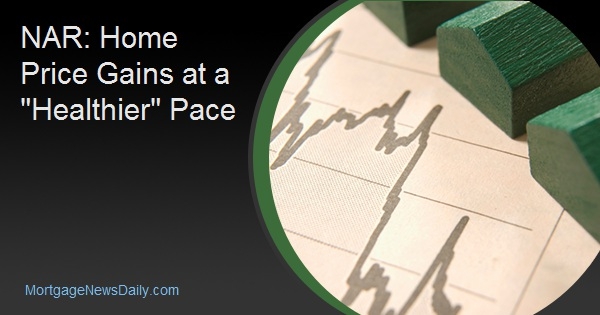An asset bubble can burst, or it can develop a slow leak, and float more or less gradually back to normal levels. The National Association of Realtors'® (NAR's) quarterly report on existing homes and metro home sales seems to indicate that the housing market, where skyrocketing prices were a concern not that long ago, is following the latter pattern. Not only are sales slowing, but inventories are growing, and appreciation appears to be gradually decelerating.
The NAR said the median price of a single-family home sold in the fourth quarter of 2018 was $257,600, a 4.0 percent increase from the median of $247,800 a year earlier. The year-over-year gain in the fourth quarter of 2017 was 5.3 percent.
Home prices increased on an annual basis in 163 of the 178 metropolitan statistical areas (MSAs) tracked by the report, unchanged from a year ago. But while increases were in the double digits for 26 areas at that point and 18 in the third quarter of 2018, only 14 saw that kind of strong gain in the fourth quarter.
Lawrence Yun, NAR chief economist, says in light of the various hurdles for 2018, the close of the fourth quarter was promising. "Home prices continued to rise in the vast majority of markets but with inventory steadily increasing, home prices are, on average, rising at a slower and healthier pace," he said.
Sales of existing homes decreased 1.8 percent to a seasonally adjusted annual rate of 5.180 million in the fourth quarter, compared to 5.273 million the third quarter. Sales were down 7.4 percent year-over-year.
At the end of the fourth quarter, there were 1.55 million existing homes available for sale, 6.2 percent more than at the end of the fourth quarter in 2017. The inventory across the quarter averaged 4.0 months at the current rate of sales. A year earlier the supply averaged 3.5 percent.
Yun said the West Coast needs more homes built. "The region, where home prices have nearly doubled in six years, is undergoing the biggest shift with the slowest price gain and large buyer pullback," he said.
National family median income rose to $77,392 in the fourth quarter, while overall affordability decreased from a year ago due to higher mortgage rates and home prices. To purchase a single-family home at the national median price, a buyer making a 5 percent down payment would need an income of $62,954, at 10 percent down the payment would require an income of $59,640, and $53,013 would be necessary with a 20 percent down payment.
The San Jose MSA continues to be the most expensive housing market in the US; the median existing home price was $1,250,000. The San Francisco Bay areas had a median of $952,300 and Urban Honolulu was at $812,900. The other two cities in the top five, Anaheim/Santa Ana and San Diego, had median prices of $799,000 and $626,000 respectively.
At the other end of the spectrum, Decatur, Illinois bumped Youngstown, Ohio out of its long-time role as the least expensive MSA with a median price of $89,300. Youngstown's median was $97,200 followed by Cumberland, Maryland, $109,100; Elmira, New York, $111,400; and Erie, Pennsylvania, $113,300.
The median existing condo price in the 61 areas tracked was $237,900 in the fourth quarter, up 0.3 percent from the fourth quarter of 2017. Seventy-five percent of metro areas showed gains in median condo prices from a year ago.
"Housing affordability will be the key to sustained healthy growth in the housing market in the upcoming years. That requires more homebuilding of moderately priced homes," Yun said. "Housing starts fell far short of historically normal levels, with only 9.6 million new housing units added in the past decade; compared to 15 to 16 million that would have been needed to meet our growing population and 20 million new job additions. He added that local zoning changes, expanding job training in the construction trades, and the use of tax breaks for developers in designated Opportunity Zones can play an important role in providing a future supply of housing.
Total existing-home sales in the Northeast increased 3.9 percent quarter-over-quarter to an annual rate of 707,000 but were down 5.4 percent from a year earlier. The median existing single-family home price in the Northeast was $286,000 in the fourth quarter, an annual increase of 6.5 percent.
Existing home sales fell 0.3 percent in the Midwest and are 5.9 percent below a year ago. The median price rose 1.6 percent to $196,900.
Sales in the South declined 2.0 percent in the fourth quarter and were 5.4 percent lower than the fourth quarter of 2017. The median price was up 3.3 percent to $228,200.
Sales in the West slowed by 6.5 percent and 13.9 percent compared to the two earlier periods. The median home price rose 1.8 percent to $383,100.







